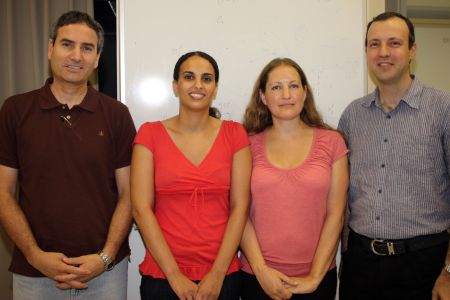The gene that the researchers followed is a control gene that when the transcription activity it carries out goes wrong the cell becomes cancerous, and in doing so they gained new insights into processes related to the disruption of control in cancer cells

A team of researchers from several departments at Bar-Ilan University from Bar-Ilan achieved a breakthrough in the ability to observe the activity of a single gene (allele) inside a living cell. The journal Nature Methods publishes the study online today.
The research was carried out by PhD student Sharon Junger in the laboratory of Dr. Yaron Shevtal from the Faculty of Life Sciences, in collaboration with Dr. Yuval Groeini and PhD student Liat Altman in the Department of Physics in Bar-Ilan. All researchers from both groups also belong to the Center for Nanotechnology at Bar-Ilan University.
"This is the first time that it was possible to see the activity of a single gene inside human cells in real time and follow it over a long period of time. From monitoring the transcription process of the instructions from the genome to RNA for the purpose of creating the protein for which that gene is responsible, it will be possible to understand the mechanism of control over the genes." says Dr. Shev-Tal.
According to Dr. Shevtal, in order to observe the activity of a gene - whether it "turns on" or "turns off", i.e. whether it produces the RNA it is responsible for or not, it is necessary to attach a fluorescent marker to the gene products. The cells in which these experiments are carried out are cells produced by a commercial company that made sure that their genome had a place to receive genes that come in from the outside. The researchers have to "shoot" the desired genes into these cells, to which is attached the marker that will make it possible to identify the RNA molecules with a fluorescent microscope, and thus it will be possible to monitor their activity inside the cell. The problem with the method that existed until now was that the gene would enter the target site inside the cell not as a single copy but in hundreds of copies, and only then could the activity be observed, but this is not necessarily the natural activity that occurs in a normal cell, since genes are found in the genome as single copies.
The collaboration between the two groups - from life sciences and physics made it possible to develop the method that allows observing the gene itself in its active state and all the RNA molecules created from it. Viewing the individual gene allows scientists to distinguish fine details such as when the gene is on and when it is off without hundreds of other copies of it disrupting the view. It is also possible to quantify the number of RNA molecules created in the process, while when hundreds of copies of the gene are active, it is impossible to know how many of them were produced by a single gene.
But the researchers were not satisfied with just developing the method and they sought to derive scientific benefit from testing it on an important gene as well. Therefore, they examined the behavior of the cyclin D1 gene, whose function is to control the course of the cell cycle. In many cancer cells, including the common breast cancer, this gene has lost its control and it works non-stop instead of being turned on and off when needed by other genes that visit it.
The researchers injected living cells taken from a person with two versions of the gene. One version is normal, that is, in which the "switch" of the gene (the component of the gene that causes the gene to be turned on or off) is normal, and the other, in which the original switch was replaced by a switch of a viral gene, which makes sure to express itself all the time, thus it actually functions like the cyclin D1 gene in a cancer cell. The researchers observed gene activity in both types of cells. From the observations it became clear that while in a normal cell the gene alternately turns on or off, in the cancer cell the gene constantly produces the RNA in high quantities. The researchers found that the reason for this lies in the fact that the viral switch frequently recruits the RNA polymerase enzyme that produces the RNA molecules. On the other hand, in the normal state, the switch of the gene controls the number of enzymes that can go over the gene and create RNA. If so, in a situation of overexpression of the RNA, there is also overexpression of the protein and thus other processes in the cell go wrong in a chain reaction.
And sometimes in science there are also unexpected bonuses. Shevtal and his team noticed that these genes are also active in the phase of DNA replication before cell division. In some cells, those found in the stage before division, two copies of the gene were found. Shevtal and his staff were interested in the question of whether at this stage each of the genes produces its fixed amount of RNA and then there is actually a double amount of the substance in the cell. It turns out not. Each copy of the gene at this stage produces half of its normal amount of RNA and thus both together create the fixed amount. In other words, the researchers were able to gain fundamental new insight into the transcription process just before the cell divides.
According to Dr. Shevtal, using this new method it will be possible in the future to check with high resolution the control processes that exist in different genes and to understand the importance of the control areas in the gene in different disease states.
